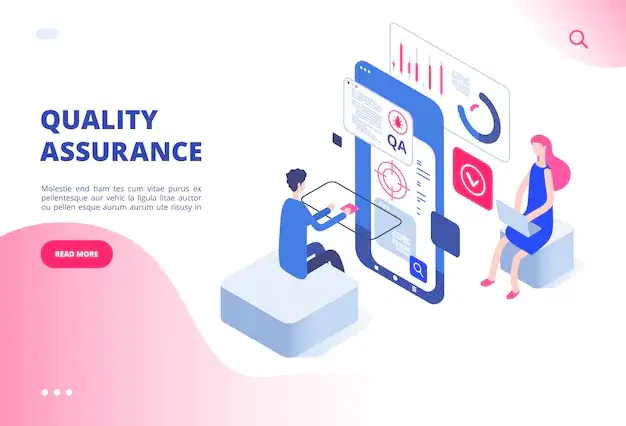
Software testing methodologies are the lifeblood of any software development project. Using the right testing approach, you can ensure that your product is defect-free and meets customer expectations.
Software products or applications require periodic checks. This is done to evaluate and verify that it’s free of bugs and functions efficiently. We will discuss how it’s done using modern software testing methodologies that will enable your team to transition more easily to efficient behavior that will lead to faster market delivery.
Here are 10 tips for success with software testing methods for your business requirements.
What is Software Testing?
Software testing is a process that checks the functionality and usability testing of the software. It helps developers fix bugs in their programs before they are released to customers. This means less time to fix problems after users complain about them online or through other channels like phone calls, etcetera.
Functional and non-functional testing is an essential part of any project. It allows you to determine if your program will work as expected before investing time or money into it. Functional tests ensure the program does what it should while identifying bugs in its logic or malfunctioning parts. In addition, non-Functional checks for data integrity by providing all information being transmitted into a system is correct each time before proceeding with an operation.
Why is Software Testing Important?
Quality control is necessary when developing software because defects can damage a brand’s reputation and lead to lost customers. In extreme cases, bugs or malfunctions may degrade interconnected systems, which could cause serious problems for the businesses involved.
Testing can be a costly process, but it’s worth the investment. Companies could save millions annually if they invest in good testing techniques and QA processes. The sooner development teams receive test feedback, the easier it will be to address issues such as architectural flaws and poor design decisions. In addition, by accelerating bug fixes through early detection in QA processes, companies can save millions per year on unnecessary costs when their products go live.
Studies have shown that more reliable and high-quality software can be delivered with fewer errors when a test is done in the development process. In addition, systems that meet or exceed customer expectations lead to greater market share for your company.
Software Testing Methodologies:
Here’s an overview of some popular and well-known types of software testing methodologies:
Agile Methodology:
The Agile model can cover software testing and development and marketing. The short iterations in this methodology, called “sprints,” are often home to new features or minor bug fixes for existing products which might be developed by design teams as small as three people at a time (a mini-iteration).
The Agile approach reduces risks by allowing teams to learn from their mistakes. With each new iteration, they can consider what happened in previous ones and adjust accordingly for future releases. According to a report by InfoQ in 2014, most firms use Agile methodology for software development projects.
The product designer should always be open to a different level of testing their designs thoroughly. If they find that some part of the design contains more bugs than predicted, then during the next iteration, they can devote more testing time and effort to this particular area for thoroughness’ sake.
A popular method of managing projects that utilize Agile testing is called Scrum. It includes features such as sprints, where each ends with a review meeting to discuss progress and plan future testing sessions for developers who work on this type over time will help them stay alert.
Waterfall Methodology:
The waterfall methodology is a project management technique that documents and plans the testing process for you in detail.
The testing team makes small steps, one after another, until they reach their goal – which means this way, there are no problems or issues along your journey.
This methodology has one of the highest success rates in testing. However, a major downside to this is that it takes time for teams or clients who use these methods because they are so strict about following their guidelines precisely, which can cause errors if not done perfectly from the start-to-end.
Verification and Validation Methodology:
The verification and validation method is a step-by-step model for software testing. Its main distinguishing feature is that development happens in parallel with the process rather than after it has been completed, as conventional methods do nowadays.
Making changes at an early stage is a key benefit of this process. The team can test new features and save time in future endeavors by not having to go through all those steps again once they’re already complete with testing, etcetera.
Incremental Methodology:
The incremental software testing process is a series of smaller cycles that add value to your software product with each iteration. There are several parts in an entire cycle, and they all help make it better than before.
The incremental approach consists of design and development, testing (which can include constant monitoring), and final implementation. The main advantage of this is that it’s rather flexible, which allows for quick updates if something needs changing or adding, especially if you’re working with a small team who all have different skill sets but still need to produce quality results at any given time.
Spiral Methodology:
The spiral methodology can be considered a part of the incremental model. The four stages are planning, risk analysis, engineering, and final evaluation, where each cycle follows after another to achieve success for your project’s needs.
The model of this testing process begins with the previous stage and ends in immediate feedback for teams. This allows them to pinpoint any errors quickly, leading them down a path towards correcting what’s wrong, so it doesn’t happen again soon after.
Extreme Programming (XP Methodology):
XP methodology requires close cooperation between two testers. One team member works with the code, and another immediately reviews it, ensuring product quality before going live.
This approach allows teams to create high-quality code because every line is checked carefully. In addition, this provides peace of mind for any developer working on your software project, knowing they will not have trouble with unworked bugs or security holes at release time.
Levels of Software Test:
- Critical Path Testing: This level mainly aims at analyzing user-engaged functions regularly.
- Smoke Testing: In the Smoke test, the team verifies whether the vital features and the functions assigned to the system are working as planned.
- Extended Testing: The team conducts this test to explore that every feature is in place according to the customer’s requirements.
Top Ways to Drive Success with Software Testing Methodologies:
Hiring the best software testing team with great attention to detail will add value. When you hire an external team, you won’t have to find time to train them. Furthermore, when the testing phase starts, the team will not need your direct supervision to execute critical tasks. The team will have a proper testing strategy beforehand.
1. Planning your Testing Process:
The software industry continues to grow and change at a rapid pace. To stay ahead, we need new applications that can adapt to our ever-changing world – this way, and they will be able to stand up against today’s challenges for generations into the future.
This can only succeed with careful planning from the very beginning. Without it, you risk losing all of your work and starting again because nobody will know what happens when things go wrong.
You need an effective testing process to ensure that your software continues to function properly. An important way of doing this is by proactively finding bugs and reducing the frequency of errors to cut costs and earn customer satisfaction for years down the line.
2. Leverage Test-Driven Development:
Extreme programming is the new way to produce high-quality software. It’s a process that can adapt as requirements change, and it will help you reach team efficiency with test-driven development, so testers are empowered in their job even more than before.
The test-driven development cycle is an approach where tests are written before implementing code. The team can repeat short, quick cycles for developing new features or fixing existing bugs. In addition, this method relies on verifying what you want in your program first instead of guessing, as most other methods do, thus saving time and money.
Developers who use the test-driven development method typically perform automated tests before they write any production code. These are used to ensure there isn’t anything wrong with what’s being created, and if something does come up, it can be fixed quickly by simply running through these steps until everything works as expected.

Freepik
3. Conducting Formal Technical Review:
The software engineering team performs a formal review to uncover errors in the early development phases. This quality assurance activity is conducted as an all-team meeting where engineers ensure that their work meets predefined requirements and standards, working with other disciplines such as corporate IT folks or customer service representatives if necessary.
The agile method is a great way to ensure your software continues to progress through independent tests. It ensures that each change made by developers has been tested and approved before going live with them on an official platform, which means you can avoid any bugs or errors from ever happening in the first place.
Formal reviews are the best way to get feedback on your software from others in the field. Each participant will have an equal opportunity to study and present evaluations, so you must voice any concerns or suggestions before moving forward with development time frames.
A walk-through is for reviewers in attendance to assess the software’s source code, documented requirements, and software product design. In addition, the author who wrote it attends so they can answer questions about its structure or any bugs found in their work related to coding practices.
Inspections are the best ways to ensure that your product continues to meet industry standards. They can also help you find any issues before formal reviews or walkthroughs by expanding initial checks on the software itself, catching bugs in advance, and validating those previously detected ones that have been fixed.
Conducting technical reviews provides a valuable experience for your production team and junior engineers. Junior employees can learn from observing different software analysis, design, and implementation approaches while also learning how they might contribute to future project revisions without being overwhelmed with all aspects on their own.
4. Unit Testing:
Unit testing is a useful way for developers to ensure that their code works as it should. By running tests on individual components, the process can help identify any problems before giving them all out in one go and making your life easier.
Unit testing will make fixing issues easier because you can find them early on and fix them quicker than if they were discovered later in the process. TestLeft is a tool that lets advanced testers or developers take advantage of test automation with one’s favorite IDE, which also has an integrated Fastest framework for speeding up your tests.
5. Performance Testing:
Performance testing determines how an application will behave when various people in real-world situations use it. This includes determining if the responsiveness and stability are appropriate for each particular user situation, which is segregated into four types of testing:
- Load Testing: The load test process is designed to increase simulated demand on your software, application, or website. The goal behind this type of benchmarking is that you can see how well the system will handle when faced with higher-than-average traffic loads – which might likely happen one day.
- Stress Testing: Stress testing is important because it helps determine how your computer will handle the maximum load by applying realistic and unrealistic scenarios. If something goes wrong on launch day, we know exactly where the breakdown occurs so that it doesn’t happen again.
- Endurance Testing: This aims to analyze an application’s behavior over longer periods, simulating sustained use. It helps uncover memory leaks by ensuring that your system can keep up with the demands it makes on its resources (such as processor speed).
- Spike Testing: Spike testing is when you want to see what happens when the load becomes too much for your application. You can use this information as a warning sign, telling us about potential problems with our system or code before they become overwhelming and needlessly crash due to huge demand spikes.

6. Automated Testing:
To be successful, software teams need a deep understanding of their user personas. A persona reflects the behavior patterns and goals that an end-user or target audience will have when using your product. This helps testers uncover bugs easily by thinking about how they would approach it themselves as if being shown on the screen right now.
User personas are crucial for the last phase of software testing when you need to find perfect end-user candidates. UAT or user acceptance testings help actual users execute essential tasks and required requests so bugs hiding within your system can be revealed with their help.
To ensure the success of your UAT process, make sure you have selected end-user testers who will approach this task with care and attention. To do so requires following these key practices:
Choose eager end-users: An end-user with experience using the software will be able to provide much more thorough feedback than just an average user – they’ll know what features stand out and which ones don’t work as promised based on their own experiences in use.
7. Acceptance Testing:
Acceptance testing is vital for ensuring that your software meets all software requirements before being released. You will need to get the product into a beta test and end-users, who can provide valuable feedback on how well-designed something works in practice rather than just theory-crafting online or in an office alone.
8. Integration Testing:
Integration testing ensures that the interactions between different modules or components of an application work as expected. This process tests each module individually and then combines them into a group test so they can be checked against their intended functionality together, improving efficiency while ensuring your app has no bugs.
Integration tests are a great way to ensure your application functions properly and without bugs. Either developers or independent testers usually conduct continuous testing, which is usually a combination of automated functional and manual testing, to gain insight into how well their work runs together as one system. Still, there’s no limit on who can do this.
9. Security Testing:
There is a growing concern and need for data security to be used in the software. Security testing helps determine if your information and any sensitive or important resources within these systems are protected from cyber-attacks. Additionally, ensuring they’re not susceptible to vulnerabilities that could allow hackers access to vulnerable parts of their codebase would give them complete control over what you do on our website. According to reports, the cybersecurity sector is expected to spend $133.7 billion in 2022.
The tester aims to verify that the application is robust enough for users by applying six security principles. This includes integrity, confidentiality, and authentication–the first three will protect you from any external threats while still allowing internal ones; availability ensures there won’t be downtime if something goes wrong on either end (or even during testing). Finally, non-repudiation makes sure nobody can claim they did not do what was asked despite providing evidence otherwise.
10. Compatibility Testing:
Compatibility testing verifies that your software works seamlessly across different operating systems, platforms, and browsers. It ensures consistent functionality in all environments you expect to encounter end users of the product – which means it’s a vital step towards ensuring customer satisfaction.
Conclusion:
Software testing methodologies are important for quality assurance. Using the right techniques, you can ensure that your software is ready for public release. There are different ways to test software, and it’s important to find the right ones for your team and project. Using the right approach can improve quality while meeting deadlines and budgets.

A fun-loving, creative, and passionate writer. Experienced as a curriculum writer for kids at CompuSkool (Information Technology) written interactive learning materials that engaged young minds between 3 to 17 year olds across different technology areas. After a break from writing, now pursuing passion through blogging. Now a technical writer at Squash Apps. Waiting for the future to reveal itself as days unfold.


